
mentals-ai
No code AI agents
Stars: 376
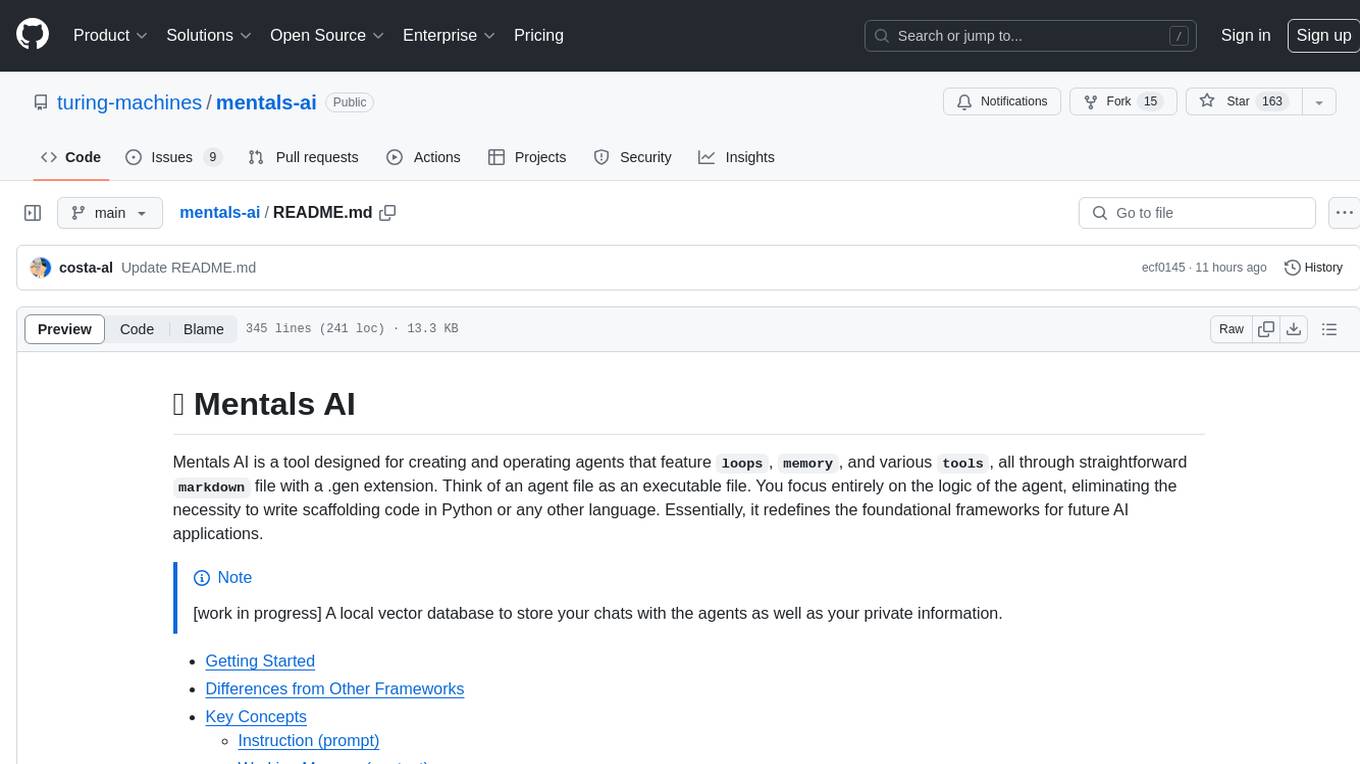
Mentals AI is a tool designed for creating and operating agents that feature loops, memory, and various tools, all through straightforward markdown syntax. This tool enables you to concentrate solely on the agent’s logic, eliminating the necessity to compose underlying code in Python or any other language. It redefines the foundational frameworks for future AI applications by allowing the creation of agents with recursive decision-making processes, integration of reasoning frameworks, and control flow expressed in natural language. Key concepts include instructions with prompts and references, working memory for context, short-term memory for storing intermediate results, and control flow from strings to algorithms. The tool provides a set of native tools for message output, user input, file handling, Python interpreter, Bash commands, and short-term memory. The roadmap includes features like a web UI, vector database tools, agent's experience, and tools for image generation and browsing. The idea behind Mentals AI originated from studies on psychoanalysis executive functions and aims to integrate 'System 1' (cognitive executor) with 'System 2' (central executive) to create more sophisticated agents.
README:
Mentals AI is a tool designed for creating and operating agents that feature loops, memory, and various tools, all through straightforward markdown file with a .gen extension. Think of an agent file as an executable file. You focus entirely on the logic of the agent, eliminating the necessity to write scaffolding code in Python or any other language. Essentially, it redefines the foundational frameworks for future AI applications 🍓
[!NOTE]
- [work in progress] A local vector database to store your chats with the agents as well as your private information. See memory branch.
- [work in progress] Web UI with agents, tools and vector storage
Word chain game in a self-loop controlled by LLM:

NLOP — Natural Language Operation
Or more complex use cases:
| 🔄 Any multi-agent interactions | 👾 Space Invaders generator agent | 🍄 2D platformer generator agent |
|---|---|---|
 |
 |
 |
Or help with the content:
- Collect YouTube videos on a given topic and save to a .csv file with the videos, views, channel name, and link;
- Get the transcription from the video and create a table of contents;
- Take top news from Hacker News, choose a topic and write an article on the topic with the participation of the critic and save to a file.
All of the above examples are located in the agents folder.
[!NOTE] Llama3 support is available for providers using a compatible OpenAI API.
Begin by securing an OpenAI API key through the creation of an OpenAI account. If you already have an API key, skip this step.
Prerequisites
Before building the project, ensure the following dependencies are installed:
- libcurl: Used for making HTTP requests
- libfmt: Provides an API for formatting
- pgvector: Vector operations with PostgreSQL
- poppler: Required for PDF processing
Depending on your operating system, you can install these using the following commands:
Linux
sudo apt-get update
sudo apt-get install libcurl4-openssl-dev libfmt-dev libpoppler-devmacOS
brew update
brew install curl fmt popplerWindows
For Windows, it's recommended to use vcpkg or a similar package manager:
vcpkg install curl fmt popplerpgvector installation
[!NOTE] In the
mainbranch you can skip this step
Clone the repository
git clone https://github.com/turing-machines/mentals-ai
cd mentals-aiConfiguration
Place your API key in the config.toml file:
[llm]
# OpenAI
api_key = ""
endpoint = "https://api.openai.com/v1"
model = "gpt-4o"Build the project
makeRun
./build/mentals agents/loop.gen -dMentals AI distinguishes itself from other frameworks in three significant ways:
- The
Agent Executor🧠 operates through a recursive loop. The LLM determines the next steps: selecting instructions (prompts) and managing data based on previous loops. This recursive decision-making process is integral to our system, outlined in mentals_system.prompt - Agents of any complexity can be created using
Markdown, eliminating the need for traditional programming languages. However, Python can be integrated directly into the agent'sMarkdownscript if necessary. - Unlike platforms that include preset reasoning frameworks, Mentals AI serves as a blank canvas. It enables the creation and integration of your own reasoning frameworks, including existing ones:
Tree of Thoughts,ReAct,Self-Discovery,Auto-CoT, and others. One can also link these frameworks together into more complex sequences, even creating a network of various reasoning frameworks.
The agent file is a textual description of the agent instructions with a .gen extension.
Instruction is the basic component of an agent in Mentals. An agent can consist of one or more instructions, which can refer to each other.
Instructions can be written in free form, but they always have a name that starts with the # symbol. The ## use: directive is used to specify a reference to other instructions. Multiple references are listed separated by commas.
Below is an example with two instructions root and meme_explain with a reference:
# root
## use: meme_explain
1. Create 3 memes about AGI;
2. Then do meme explain with meme per call;
3. Output memes and their explanations in a list.
# meme_explain
Explain the gist of the meme in 20 words in medieval style.
Return explanation.
In this example, the root instruction calls the meme_explain instruction. The response from meme_explain is then returned to the instruction from which it was called, namely the root.
An instruction can take an input parameter, which is automatically generated based on the context when the instruction is called. To specify the input data more precisely, you can use a free-form prompt in the ## input: directive, such as a JSON object or null.
Using a document for input:
# some_instruction
## input: design document only
Using a JSON object as input:
# duckduckgo
## input: { search_query: search query, search_limit: search limit }
Write a Python script to search in DuckDuckGo.
Simulate request headers correctly e.g. user-agent as Mozilla and Linux.
[!NOTE] Instruction calls are implemented independently from function or tool calls at OpenAI, enabling the operation of agents with models like Llama3. The implementation of instruction calls is transparent and included in the mentals_system.prompt file.
Tool is a kind of instruction. Mentals has a set of native tools to handle message output, user input, file handling, Python interpreter, Bash commands, and Short-term memory.
Ask user example:
# root
## use: user_input
Ask user name.
Then output: `Welcome, user_name!`
File handling example:
# root
## use: write_file, read_file
Write 'Hello world' to a file.
Then read and output file content.
The full list of native tools is listed in the file native_tools.toml.
Each instruction has its own working memory — context. When exiting an instruction and re-entering it, the context is kept by default. To clear the context when exiting an instruction, you can use the ## keep_context: false directive:
# meme_explain
## keep_context: false
Explain the gist of the meme in 20 words in medieval style.
Return explanation.
By default, the size of the instruction context is not limited. To limit the context, there is a directive ## max_context: number which specifies that only the number of the most recent messages should be stored. Older messages will be pushed out of the context. This feature is useful when you want to keep the most recent data in context so that older data does not affect the chain of reasoning.
# python_code_generation
## input: development tasks in a list
## use: write_file
## max_context: 5
Do all development tasks in a loop: task by task.
Save the Python code you implement in the main.py file.
Short-term memory allows for the storage of intermediate results from an agent's activities, which can then be used for further reasoning. The contents of this memory are accessible across all instruction contexts.
The memory tool is used to store data. When data is stored, a keyword and a description of the content are generated. In the example below, the meme_recall instruction is aware of the meme because it was previously stored in memory.
# root
## use: memory, meme_recall
Come up with and memorize a meme.
Call meme recall.
# meme_recall
## input: nothing
What the meme was about?
The control flow, which includes conditions, instruction calls, and loops (such as ReAct, Auto-CoT, etc.), is fully expressed in natural language. This method enables the creation of semantic conditions that direct data stream branching. For instance, you can request an agent to autonomously play a word chain game in a loop or establish an ambiguous exit condition: exit the loop if you are satisfied with the result. Here, the language model and its context determine whether to continue or stop. All this is achieved without needing to define flow logic in Python or any other programming languages.
## use: execute_bash_command, software_development, quality_assurance
...
You run in a loop of "Thought", "Action", "Observation".
At the end of the loop return with the final answer.
Use "Thought" to describe your thoughts about the task
you have been asked. Use "Action" to run one of the actions
available to you. Output action as: "Action: action name to call".
"Observation" will be the result of running those actions.
Your available actions:
- `execute_bash_command` for util purposes e.g. make directory, install packages, etc.;
- `software_development` for software development and bug fixing purposes;
- `quality_assurance` for QA testing purposes.
...
The idea behind ToT is to generate multiple ideas to solve a problem and then evaluate their value. Valuable ideas are kept and developed, other ideas are discarded.
Let's take the example of the 24 game. The 24 puzzle is an arithmetical puzzle in which the objective is to find a way to manipulate four integers so that the end result is 24. First, we define the instruction that creates and manipulates the tree data structure. The model knows what a tree is and can represent it in any format, from plain text to XML/JSON or any custom format.
In this example, we will use the plain text format:
# tree
## input: e.g. "add to node `A` child nodes `B` and `C`", "remove node `D` with all branches", etc.
## use: memory
## keep_context: false
Build/update tree structure in formatted text.
Update the tree structure within the specified action;
Memorize final tree structure.
Next we need to initialize the tree with initial data, let's start with the root instruction:
# root
## use: tree
Input: 4 5 8 2
Generate 8 possible next steps.
Store all steps in the tree as nodes e.g.
Node value 1: "2 + 8 = 10 (left: 8 10 14)"
Node value 2: "8 / 2 = 4 (left: 4 8 14)"
etc.
Calling the root instruction will suggest 8 possible next steps to calculate with the first 2 numbers and store these steps as tree nodes. Further work by the agent results in the construction of a tree that is convenient for the model to understand and infer the final answer.
4 5 8 2
├── 4 + 5 = 9 (left: 9, 8, 2)
│ └── discard
├── 4 + 8 = 12 (left: 12, 5, 2)
│ └── discard
├── 4 + 2 = 6 (left: 6, 5, 8)
│ └── discard
├── 5 + 8 = 13 (left: 13, 4, 2)
│ └── discard
├── 5 + 2 = 7 (left: 7, 4, 8)
│ └── (7 - 4) * 8 = 24
├── 8 + 2 = 10 (left: 10, 4, 5)
│ └── discard
├── 4 * 5 = 20 (left: 20, 8, 2)
│ └── (20 - 8) * 2 = 24
└── 4 * 8 = 32 (left: 32, 5, 2)
└── discard
Based on the evaluations, we have found two successful paths to reach 24:
1. From the node "5 + 2 = 7 (left: 7, 4, 8)", we have the equation: (7 - 4) * 8 = 24.
2. From the node "4 * 5 = 20 (left: 20, 8, 2)", we have the equation: (20 - 8) * 2 = 24.
Thus, the final equations using all given numbers from the input are:
1. (5 + 2 - 4) * 8 = 24
2. (4 * 5 - 8) * 2 = 24
A complete example is contained in the agents/tree_structure.gen
- [ ] Web UI -- WIP
- [ ] Vector database tools -- WIP
- [ ] Agent's experience (experimental)
- [ ] Tools: Image generation, Browser
The concept originated from studies on psychoanalysis Executive functions, Exploring Central Executive, Alan Baddeley, 1996. He described a system that orchestrates cognitive processes and working memory, facilitating retrievals from long-term memory. The LLM functions as System 1, processing queries and executing instructions without inherent motivation or goal-setting. So, what then is System 2? Drawing from historical insights, now reconsidered through a scientific lens:
The central executive, or executive functions, is crucial for controlled processing in working memory. It manages tasks including directing attention, maintaining task objectives, decision-making, and memory retrieval.
This sparks an intriguing possibility: constructing more sophisticated agents by integrating System 1 and System 2. The LLM, as the cognitive executor System 1, works in tandem with the Central Executive System 2, which governs and controls the LLM. This partnership forms the dual relationship foundational to Mentals AI.
For Tasks:
Click tags to check more tools for each tasksFor Jobs:
Alternative AI tools for mentals-ai
Similar Open Source Tools

mentals-ai
Mentals AI is a tool designed for creating and operating agents that feature loops, memory, and various tools, all through straightforward markdown syntax. This tool enables you to concentrate solely on the agent’s logic, eliminating the necessity to compose underlying code in Python or any other language. It redefines the foundational frameworks for future AI applications by allowing the creation of agents with recursive decision-making processes, integration of reasoning frameworks, and control flow expressed in natural language. Key concepts include instructions with prompts and references, working memory for context, short-term memory for storing intermediate results, and control flow from strings to algorithms. The tool provides a set of native tools for message output, user input, file handling, Python interpreter, Bash commands, and short-term memory. The roadmap includes features like a web UI, vector database tools, agent's experience, and tools for image generation and browsing. The idea behind Mentals AI originated from studies on psychoanalysis executive functions and aims to integrate 'System 1' (cognitive executor) with 'System 2' (central executive) to create more sophisticated agents.
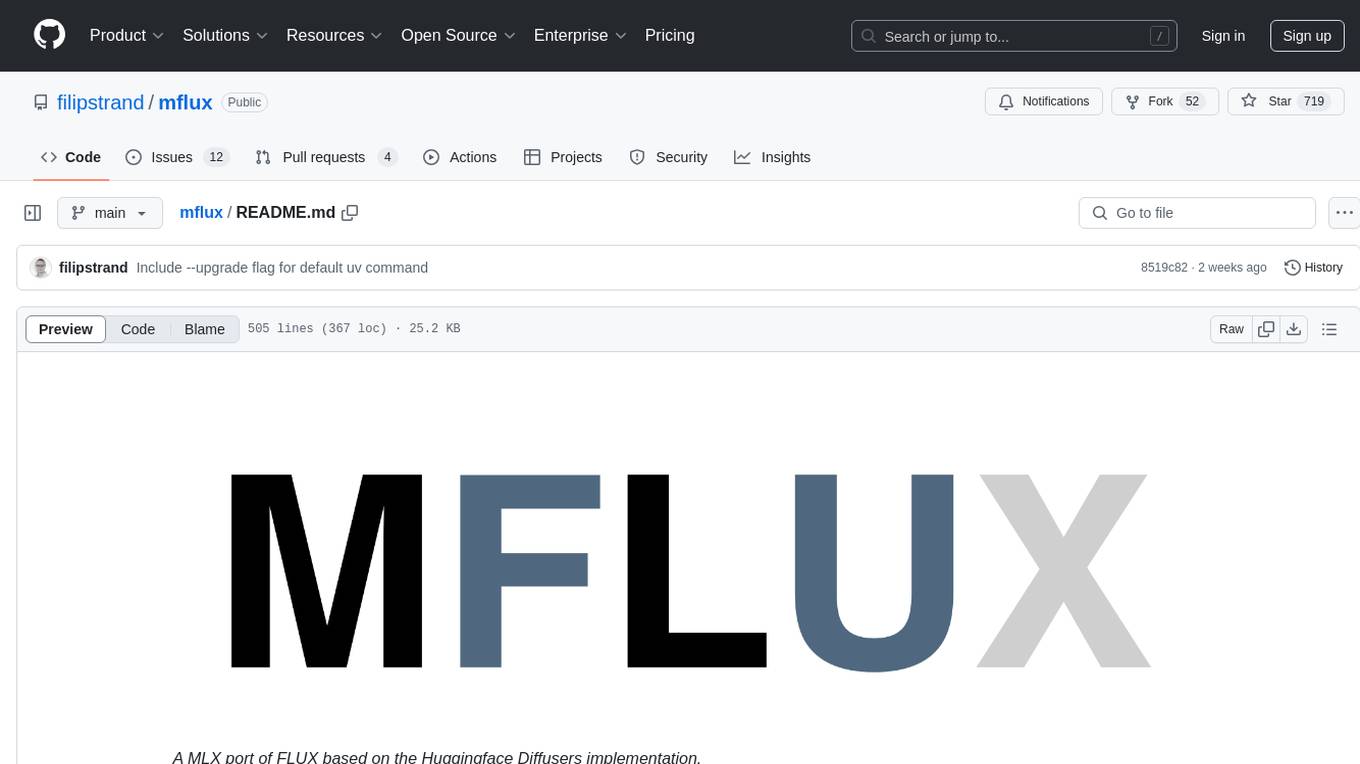
mflux
MFLUX is a line-by-line port of the FLUX implementation in the Huggingface Diffusers library to Apple MLX. It aims to run powerful FLUX models from Black Forest Labs locally on Mac machines. The codebase is minimal and explicit, prioritizing readability over generality and performance. Models are implemented from scratch in MLX, with tokenizers from the Huggingface Transformers library. Dependencies include Numpy and Pillow for image post-processing. Installation can be done using `uv tool` or classic virtual environment setup. Command-line arguments allow for image generation with specified models, prompts, and optional parameters. Quantization options for speed and memory reduction are available. LoRA adapters can be loaded for fine-tuning image generation. Controlnet support provides more control over image generation with reference images. Current limitations include generating images one by one, lack of support for negative prompts, and some LoRA adapters not working.
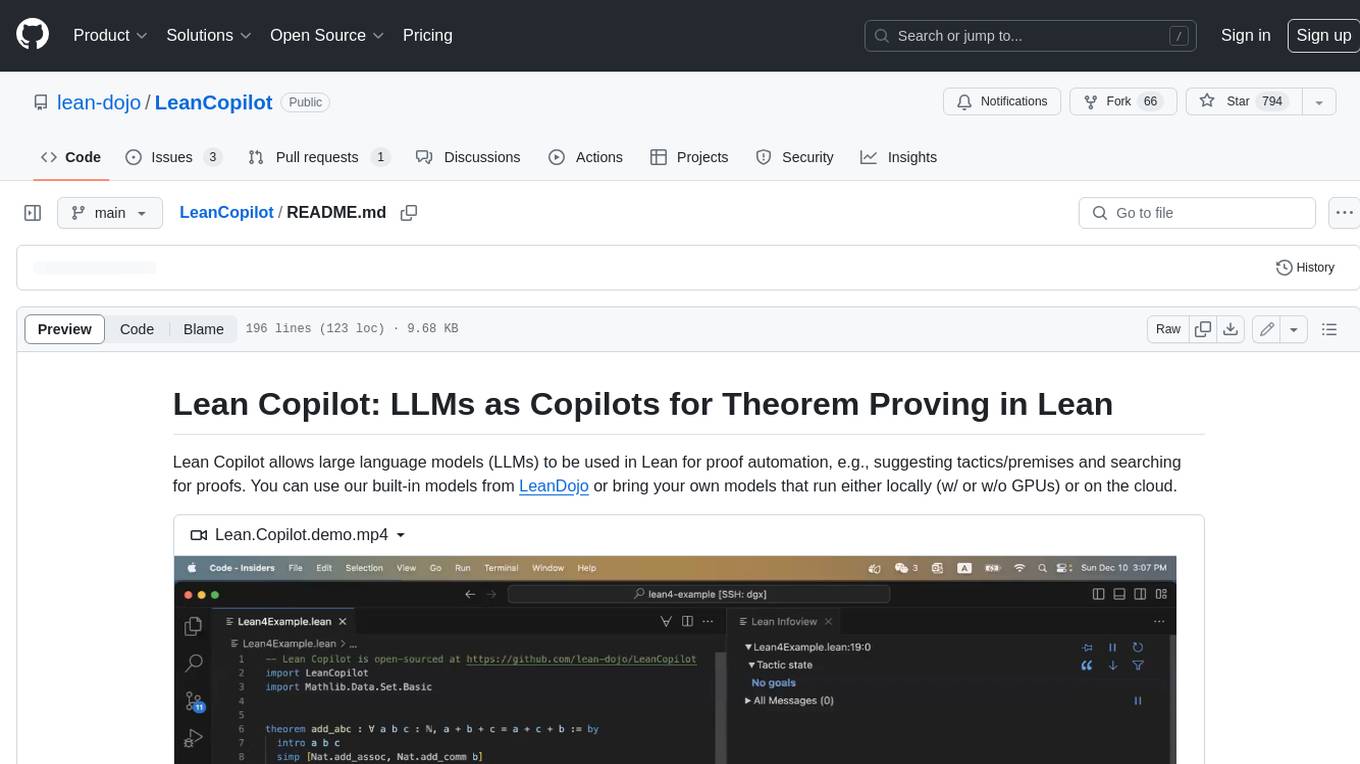
LeanCopilot
Lean Copilot is a tool that enables the use of large language models (LLMs) in Lean for proof automation. It provides features such as suggesting tactics/premises, searching for proofs, and running inference of LLMs. Users can utilize built-in models from LeanDojo or bring their own models to run locally or on the cloud. The tool supports platforms like Linux, macOS, and Windows WSL, with optional CUDA and cuDNN for GPU acceleration. Advanced users can customize behavior using Tactic APIs and Model APIs. Lean Copilot also allows users to bring their own models through ExternalGenerator or ExternalEncoder. The tool comes with caveats such as occasional crashes and issues with premise selection and proof search. Users can get in touch through GitHub Discussions for questions, bug reports, feature requests, and suggestions. The tool is designed to enhance theorem proving in Lean using LLMs.
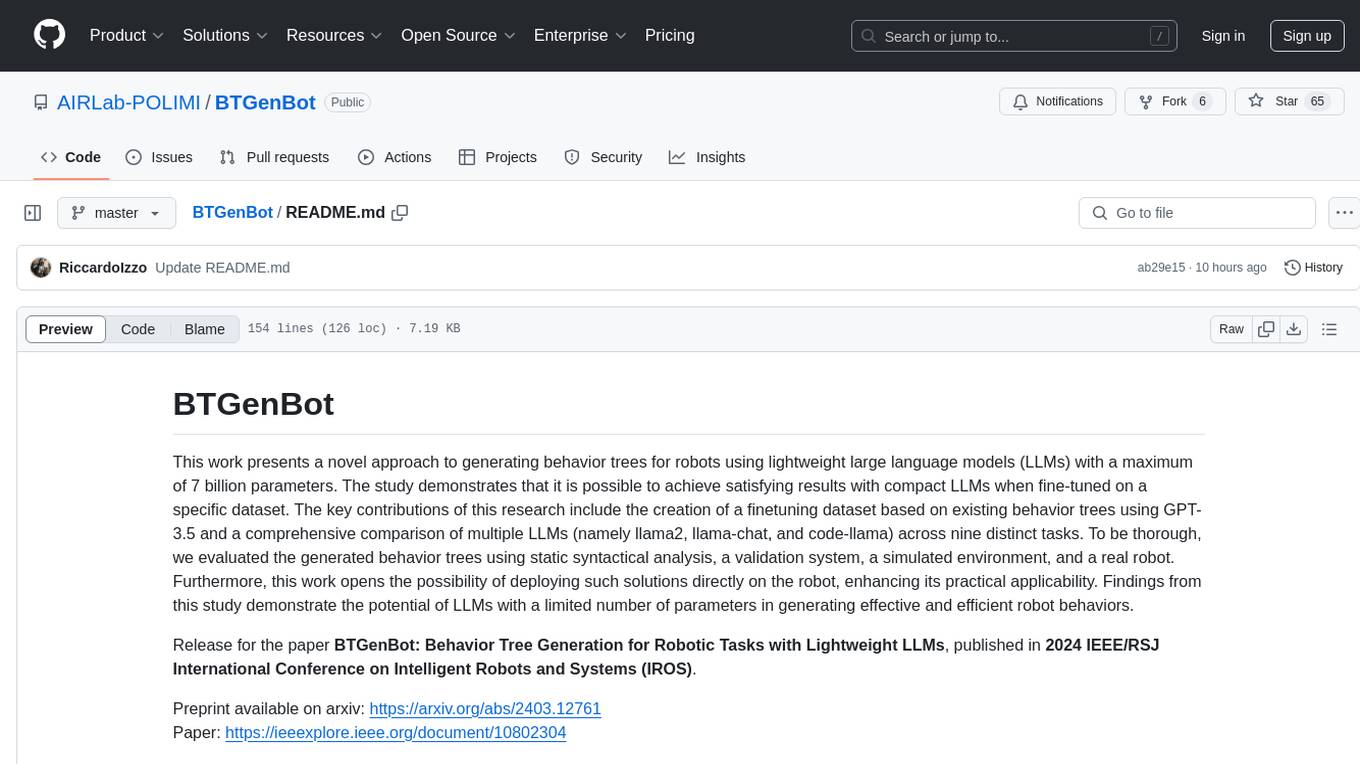
BTGenBot
BTGenBot is a tool that generates behavior trees for robots using lightweight large language models (LLMs) with a maximum of 7 billion parameters. It fine-tunes on a specific dataset, compares multiple LLMs, and evaluates generated behavior trees using various methods. The tool demonstrates the potential of LLMs with a limited number of parameters in creating effective and efficient robot behaviors.
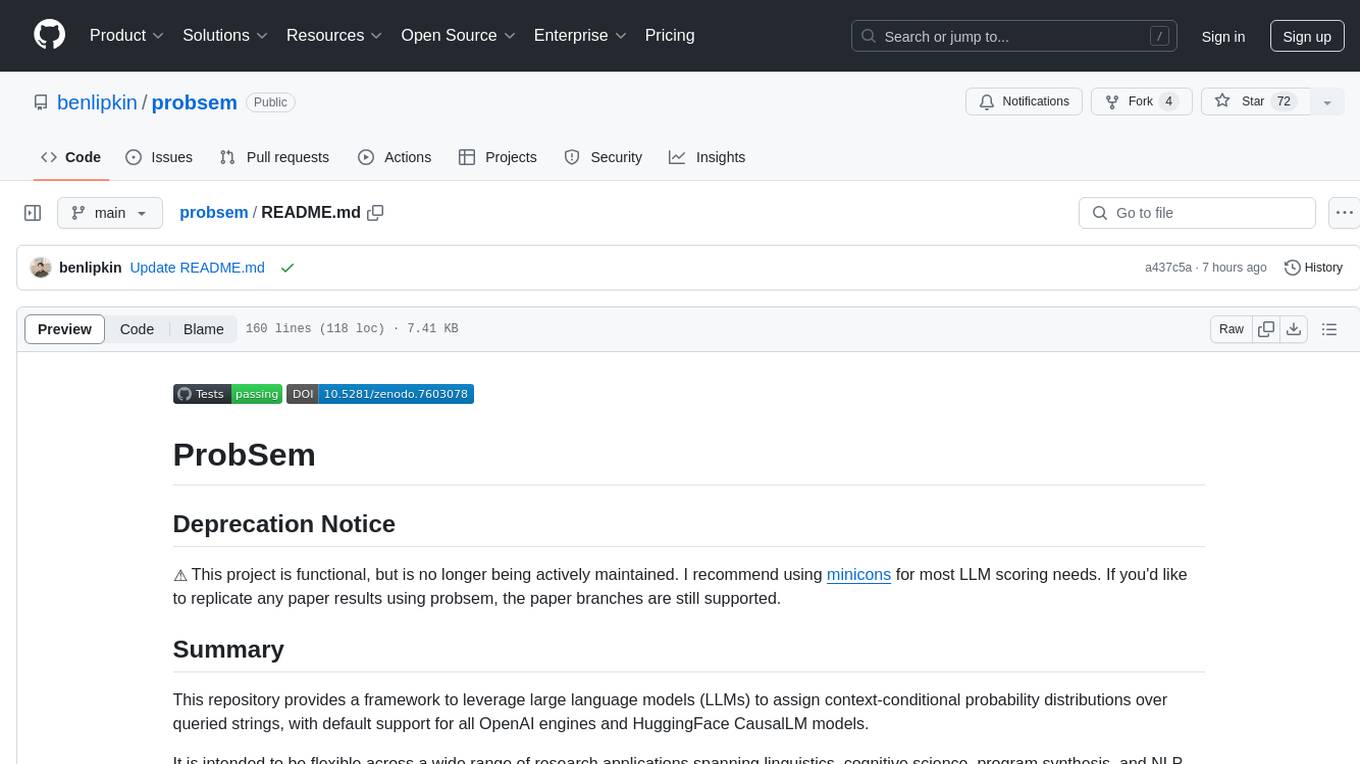
probsem
ProbSem is a repository that provides a framework to leverage large language models (LLMs) for assigning context-conditional probability distributions over queried strings. It supports OpenAI engines and HuggingFace CausalLM models, and is flexible for research applications in linguistics, cognitive science, program synthesis, and NLP. Users can define prompts, contexts, and queries to derive probability distributions over possible completions, enabling tasks like cloze completion, multiple-choice QA, semantic parsing, and code completion. The repository offers CLI and API interfaces for evaluation, with options to customize models, normalize scores, and adjust temperature for probability distributions.
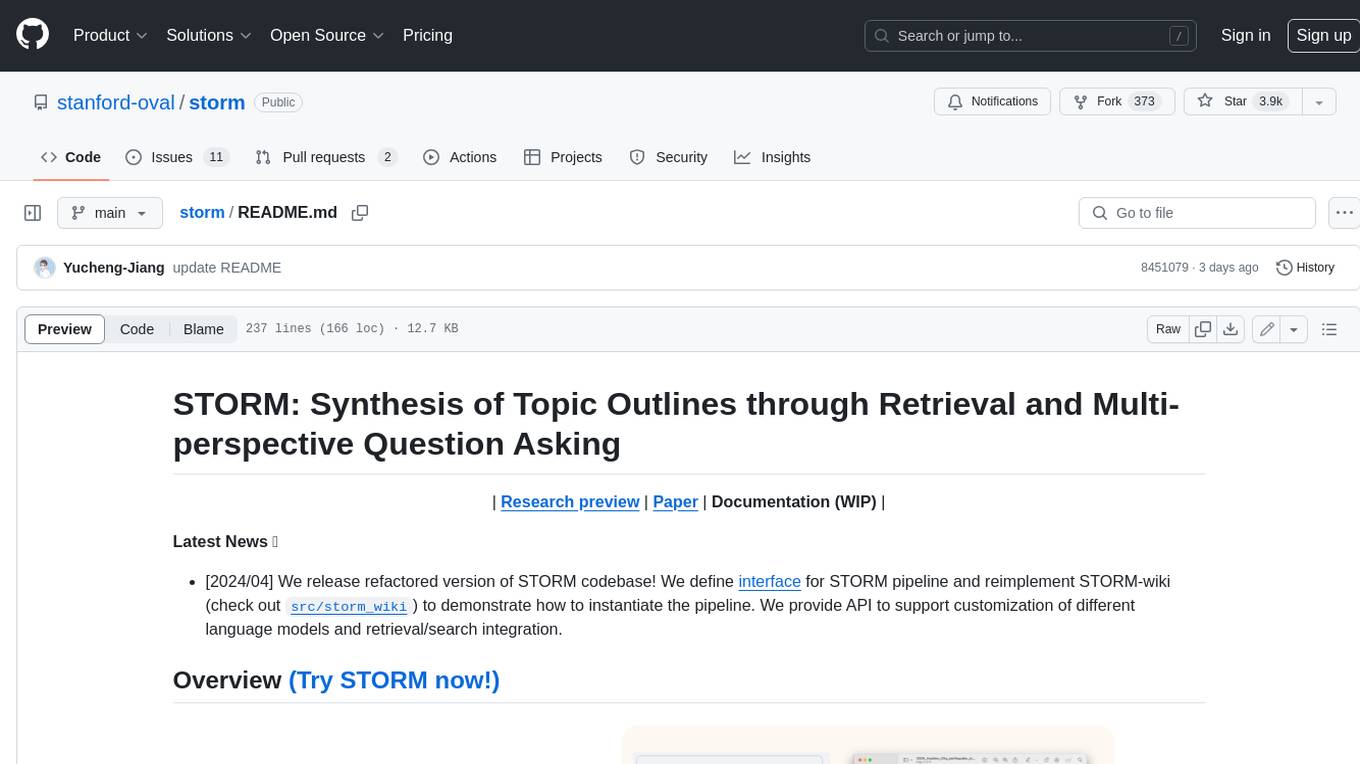
storm
STORM is a LLM system that writes Wikipedia-like articles from scratch based on Internet search. While the system cannot produce publication-ready articles that often require a significant number of edits, experienced Wikipedia editors have found it helpful in their pre-writing stage. **Try out our [live research preview](https://storm.genie.stanford.edu/) to see how STORM can help your knowledge exploration journey and please provide feedback to help us improve the system 🙏!**
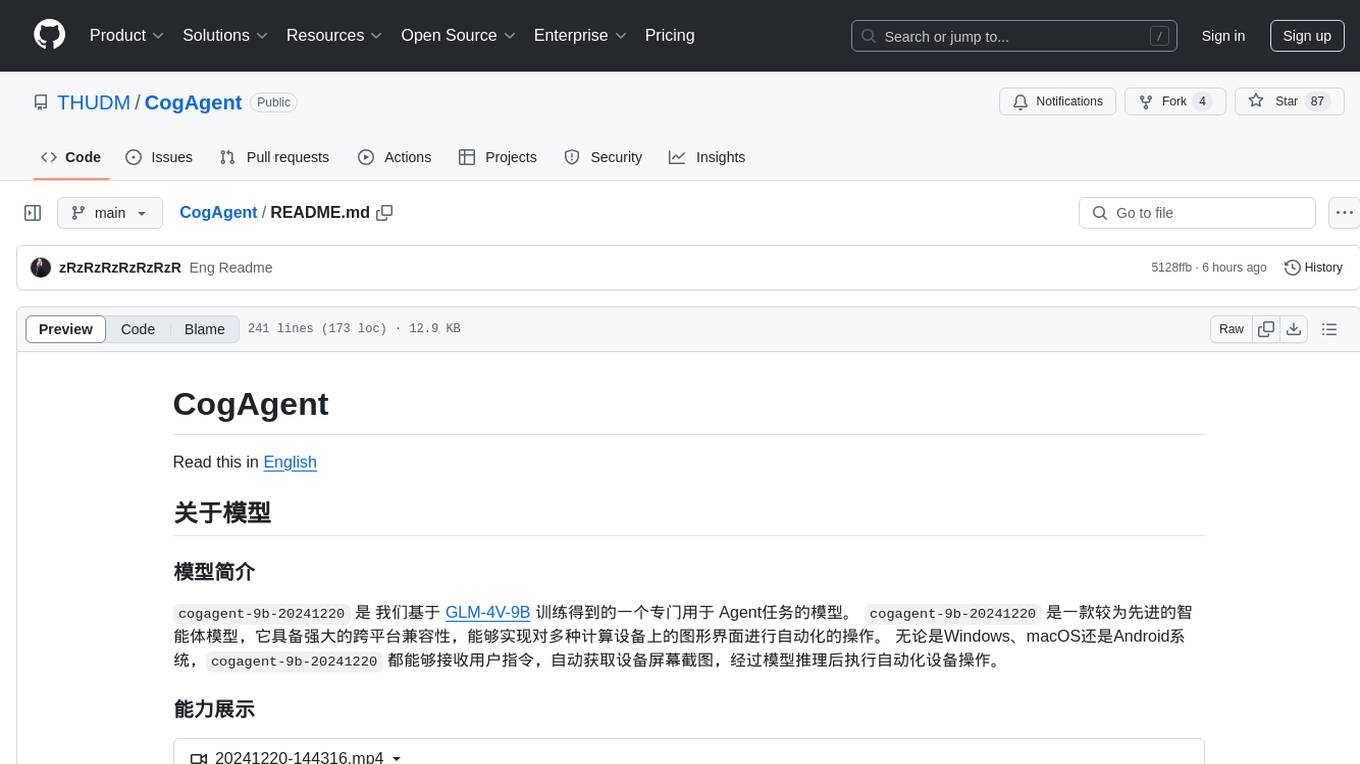
CogAgent
CogAgent is an advanced intelligent agent model designed for automating operations on graphical interfaces across various computing devices. It supports platforms like Windows, macOS, and Android, enabling users to issue commands, capture device screenshots, and perform automated operations. The model requires a minimum of 29GB of GPU memory for inference at BF16 precision and offers capabilities for executing tasks like sending Christmas greetings and sending emails. Users can interact with the model by providing task descriptions, platform specifications, and desired output formats.
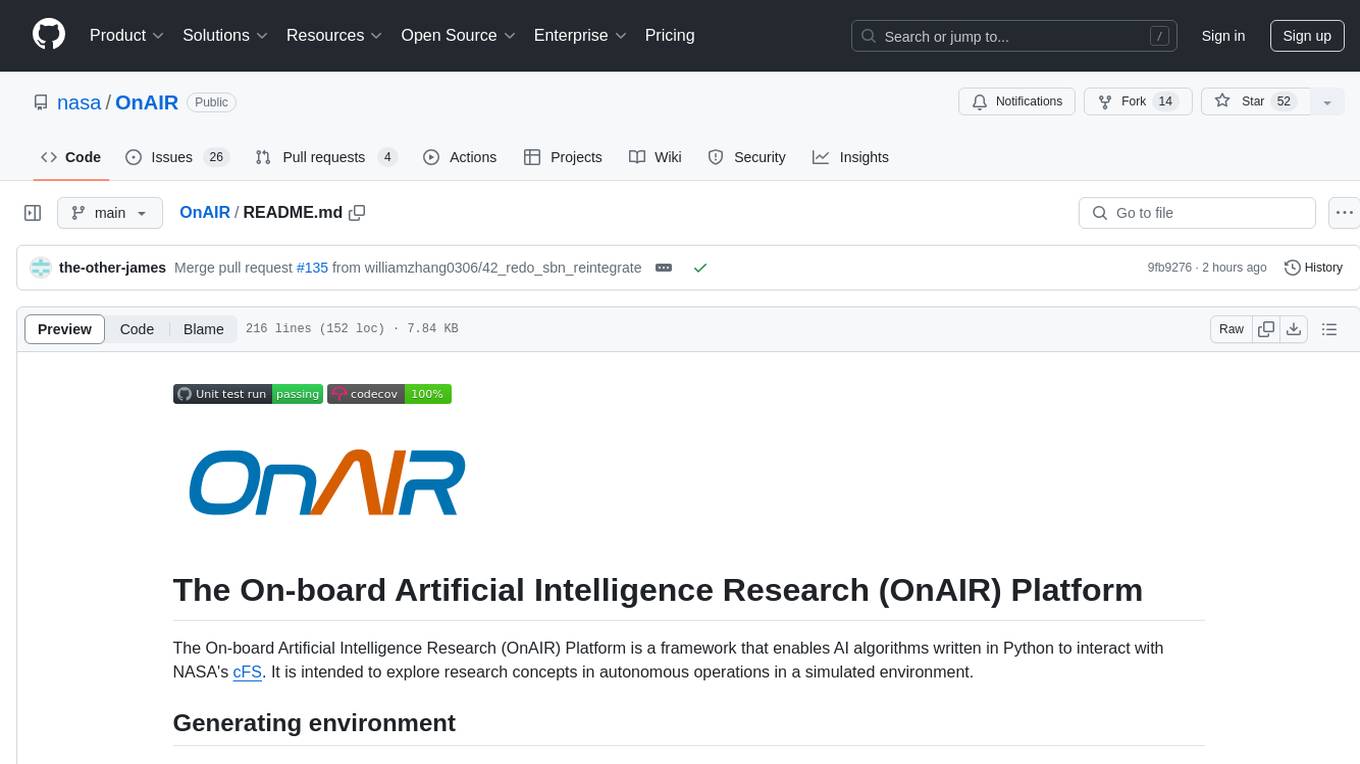
OnAIR
The On-board Artificial Intelligence Research (OnAIR) Platform is a framework that enables AI algorithms written in Python to interact with NASA's cFS. It is intended to explore research concepts in autonomous operations in a simulated environment. The platform provides tools for generating environments, handling telemetry data through Redis, running unit tests, and contributing to the repository. Users can set up a conda environment, configure telemetry and Redis examples, run simulations, and conduct unit tests to ensure the functionality of their AI algorithms. The platform also includes guidelines for licensing, copyright, and contributions to the repository.
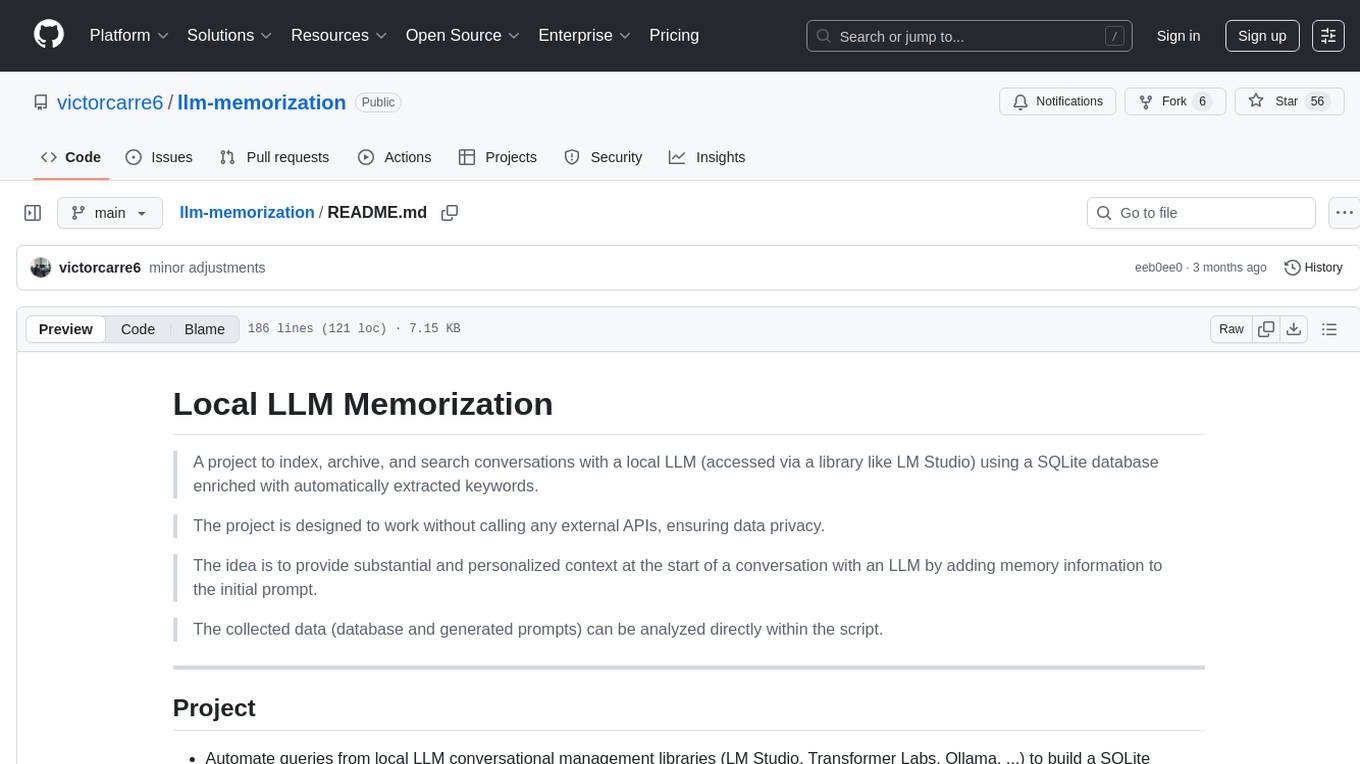
llm-memorization
The 'llm-memorization' project is a tool designed to index, archive, and search conversations with a local LLM using a SQLite database enriched with automatically extracted keywords. It aims to provide personalized context at the start of a conversation by adding memory information to the initial prompt. The tool automates queries from local LLM conversational management libraries, offers a hybrid search function, enhances prompts based on posed questions, and provides an all-in-one graphical user interface for data visualization. It supports both French and English conversations and prompts for bilingual use.
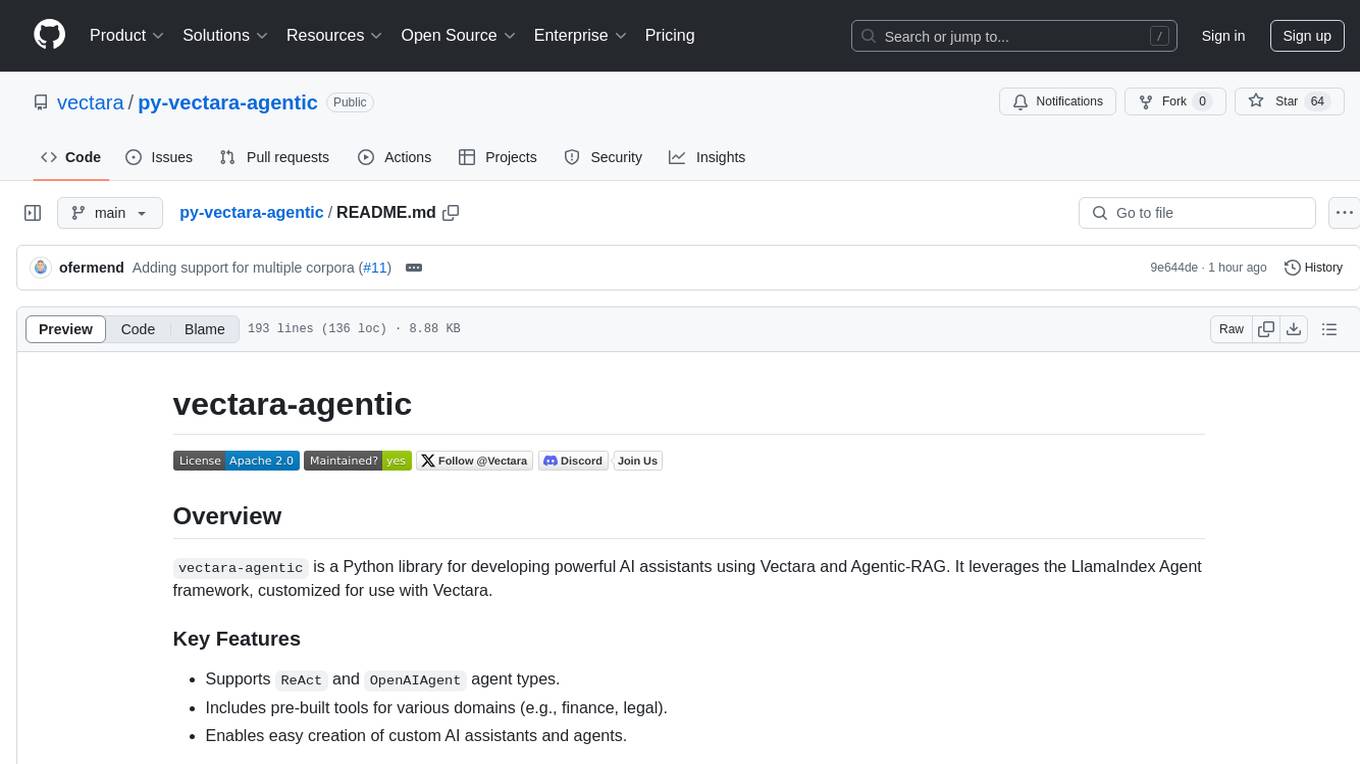
py-vectara-agentic
The `vectara-agentic` Python library is designed for developing powerful AI assistants using Vectara and Agentic-RAG. It supports various agent types, includes pre-built tools for domains like finance and legal, and enables easy creation of custom AI assistants and agents. The library provides tools for summarizing text, rephrasing text, legal tasks like summarizing legal text and critiquing as a judge, financial tasks like analyzing balance sheets and income statements, and database tools for inspecting and querying databases. It also supports observability via LlamaIndex and Arize Phoenix integration.
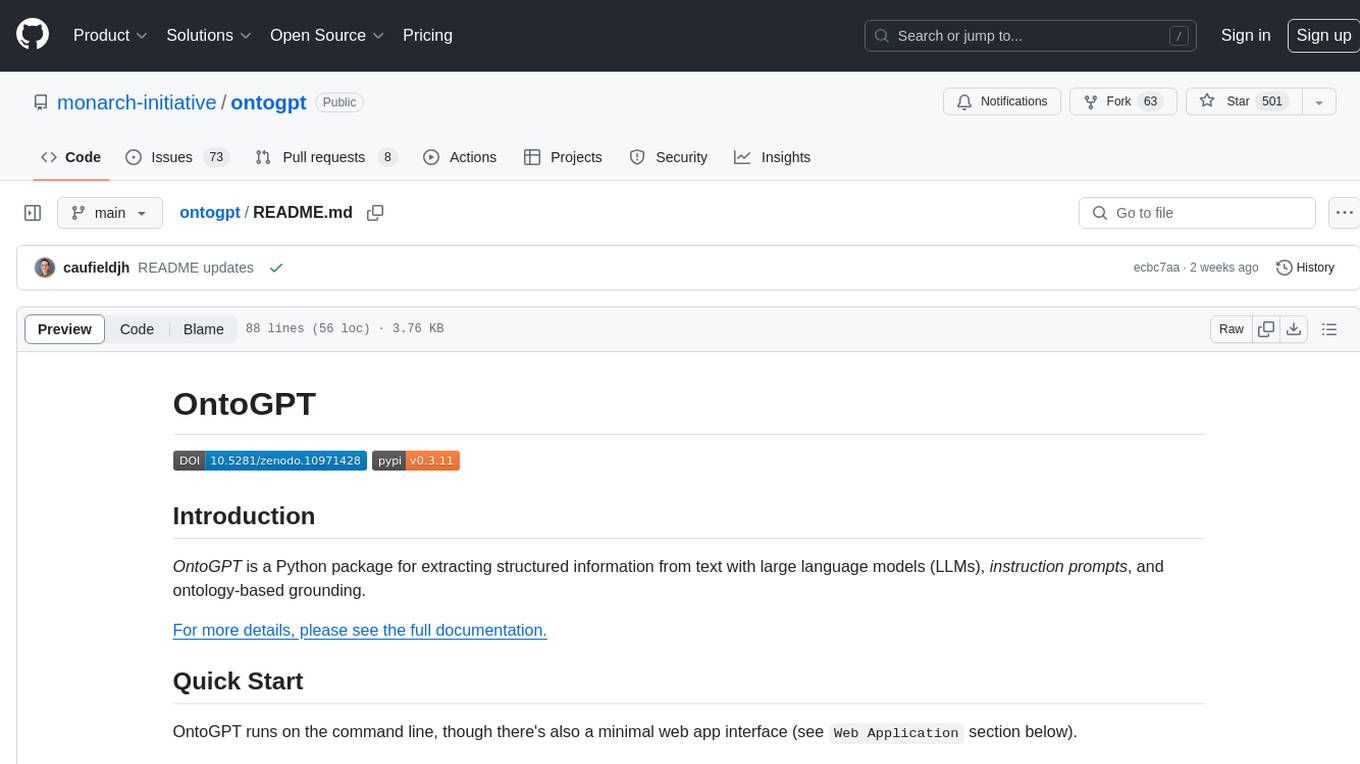
ontogpt
OntoGPT is a Python package for extracting structured information from text using large language models, instruction prompts, and ontology-based grounding. It provides a command line interface and a minimal web app for easy usage. The tool has been evaluated on test data and is used in related projects like TALISMAN for gene set analysis. OntoGPT enables users to extract information from text by specifying relevant terms and provides the extracted objects as output.
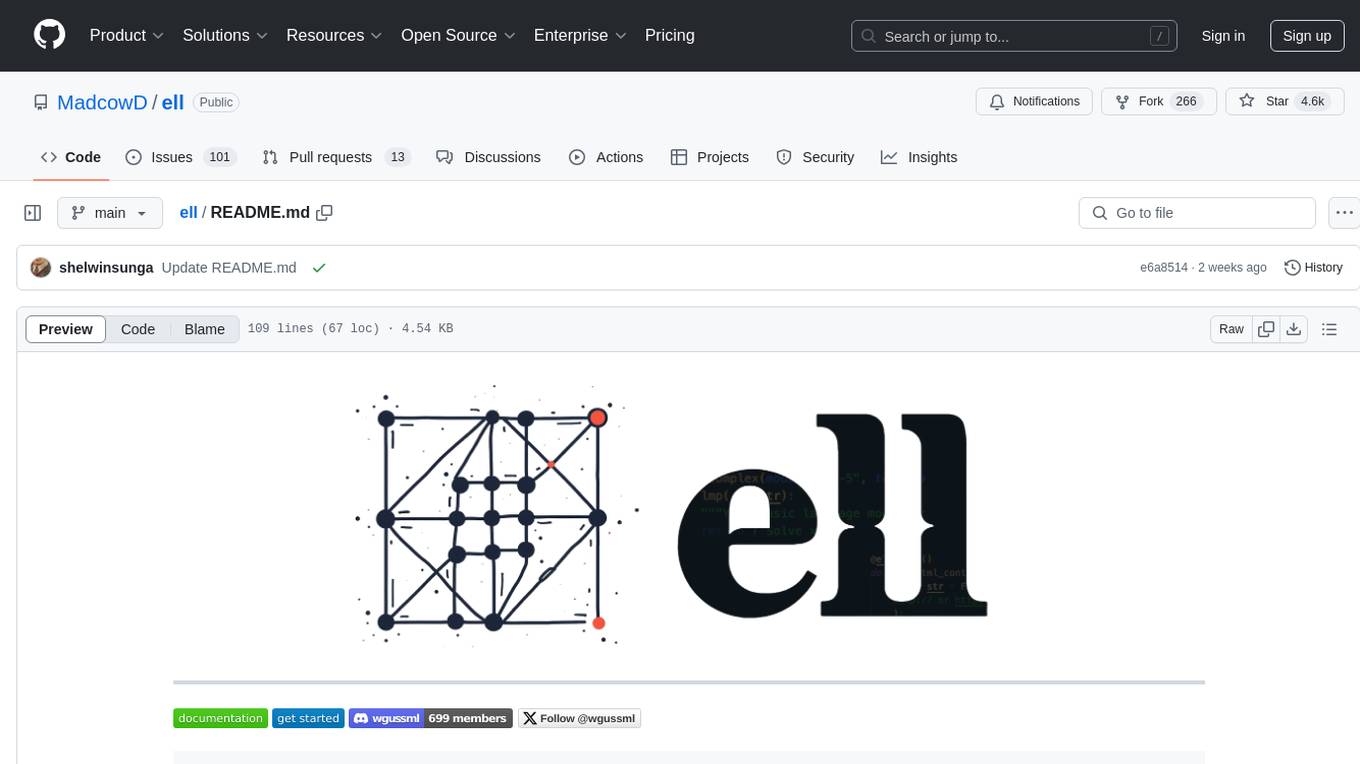
ell
ell is a lightweight, functional prompt engineering framework that treats prompts as programs rather than strings. It provides tools for prompt versioning, monitoring, and visualization, as well as support for multimodal inputs and outputs. The framework aims to simplify the process of prompt engineering for language models.
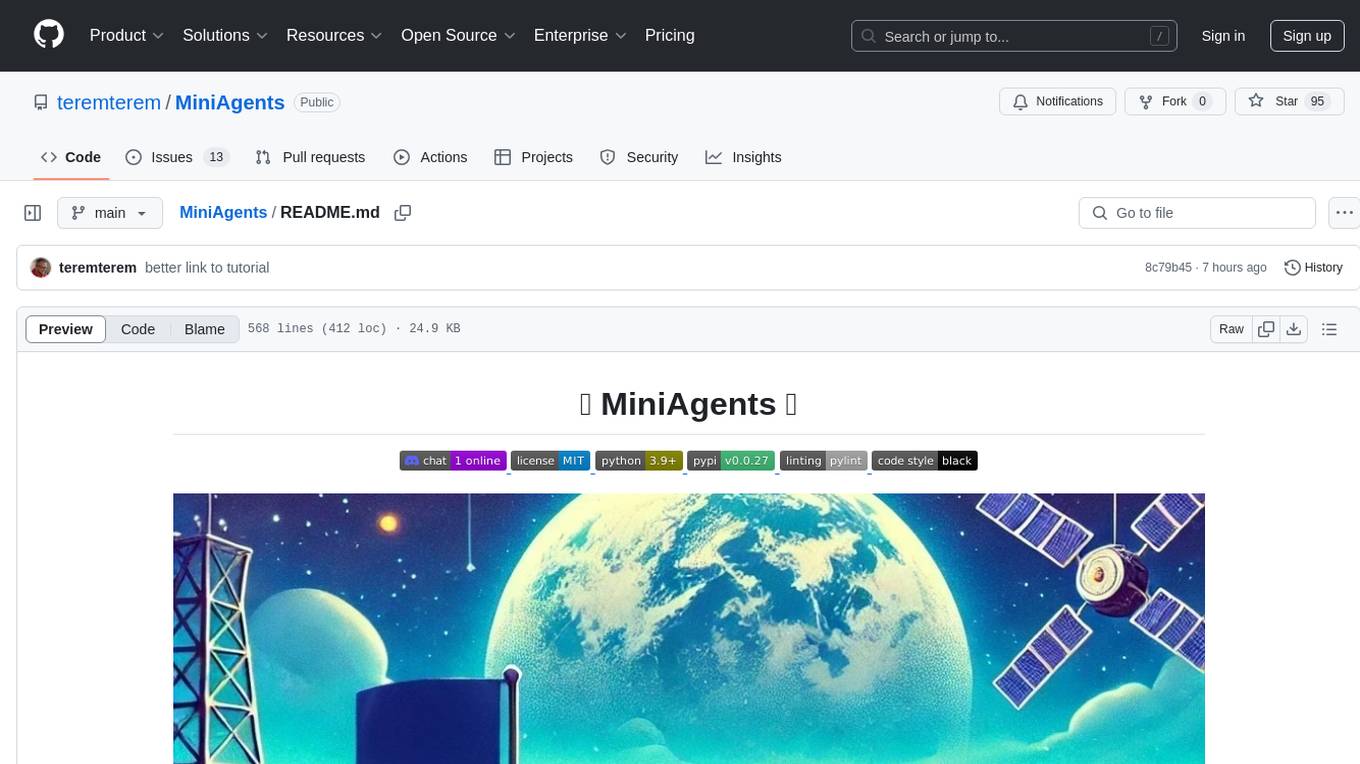
MiniAgents
MiniAgents is an open-source Python framework designed to simplify the creation of multi-agent AI systems. It offers a parallelism and async-first design, allowing users to focus on building intelligent agents while handling concurrency challenges. The framework, built on asyncio, supports LLM-based applications with immutable messages and seamless asynchronous token and message streaming between agents.
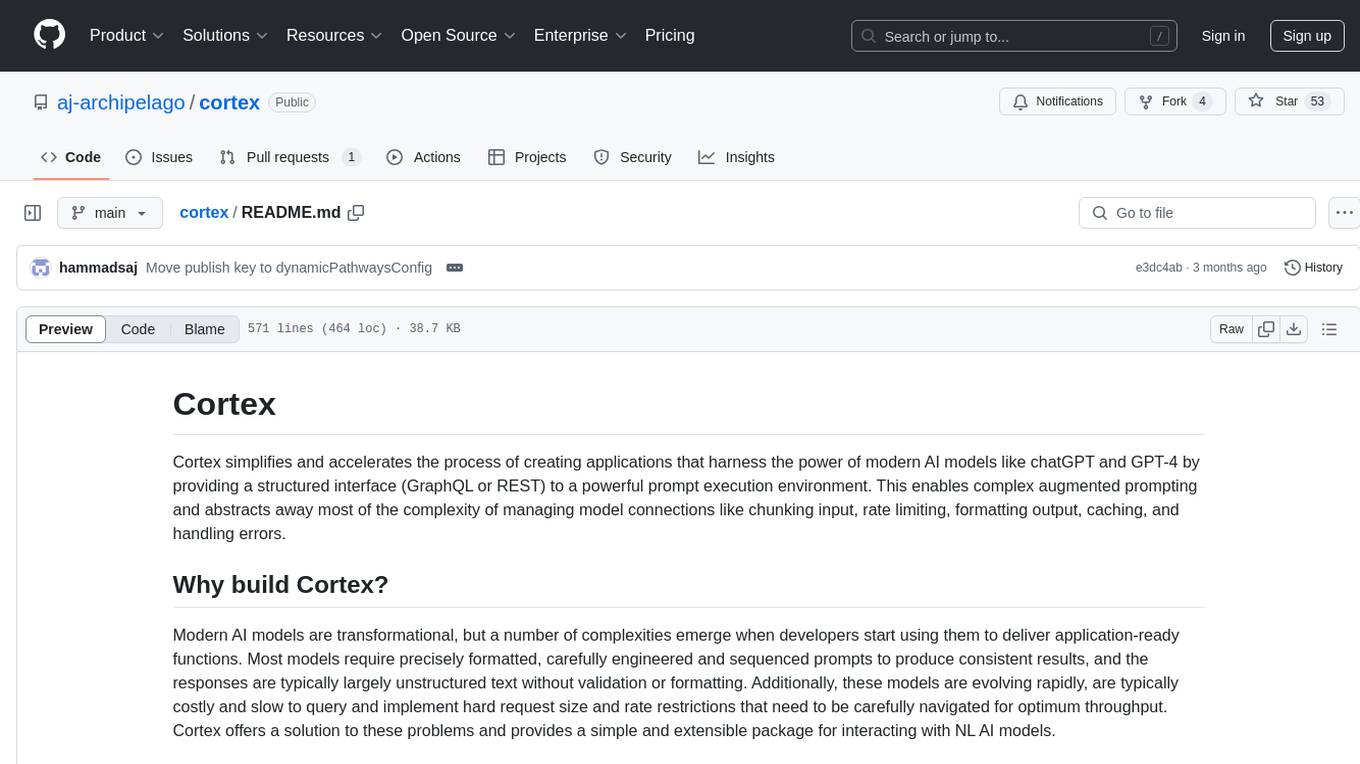
cortex
Cortex is a tool that simplifies and accelerates the process of creating applications utilizing modern AI models like chatGPT and GPT-4. It provides a structured interface (GraphQL or REST) to a prompt execution environment, enabling complex augmented prompting and abstracting away model connection complexities like input chunking, rate limiting, output formatting, caching, and error handling. Cortex offers a solution to challenges faced when using AI models, providing a simple package for interacting with NL AI models.
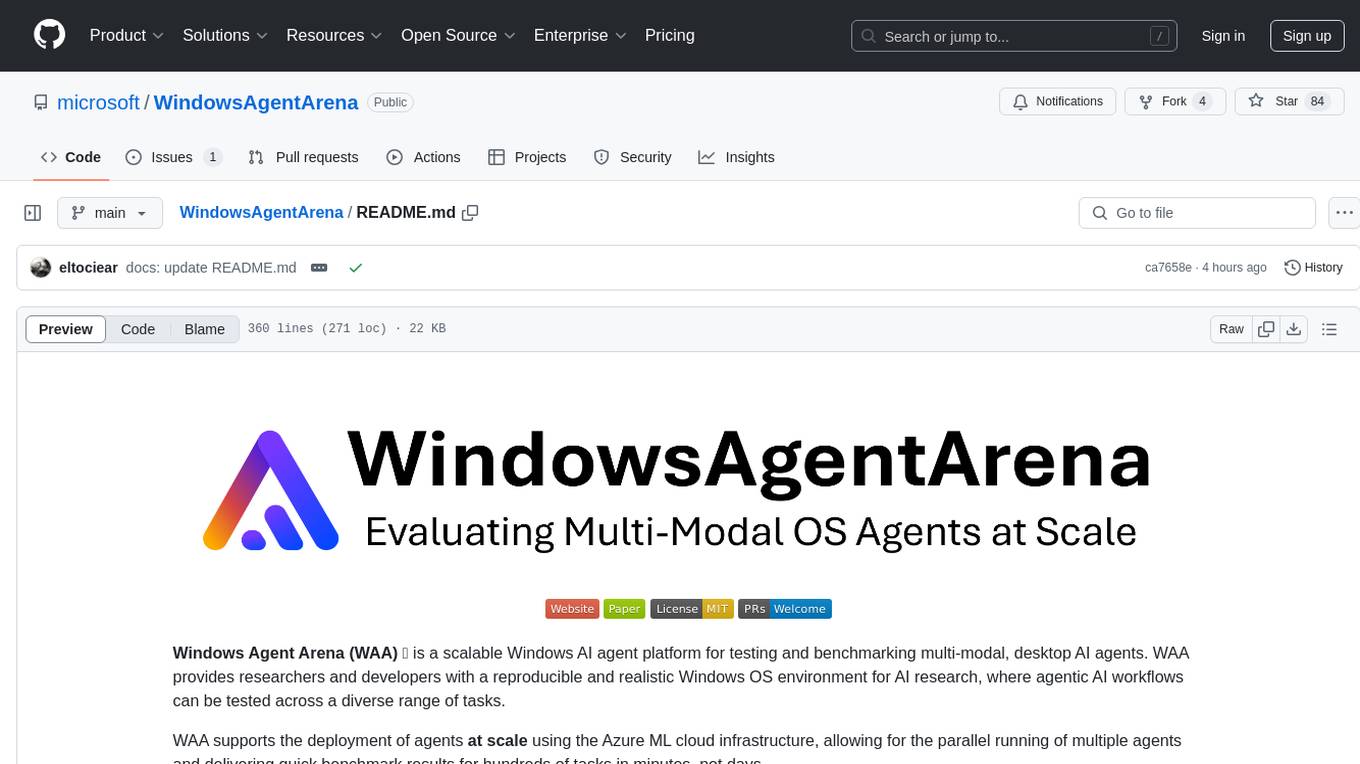
WindowsAgentArena
Windows Agent Arena (WAA) is a scalable Windows AI agent platform designed for testing and benchmarking multi-modal, desktop AI agents. It provides researchers and developers with a reproducible and realistic Windows OS environment for AI research, enabling testing of agentic AI workflows across various tasks. WAA supports deploying agents at scale using Azure ML cloud infrastructure, allowing parallel running of multiple agents and delivering quick benchmark results for hundreds of tasks in minutes.
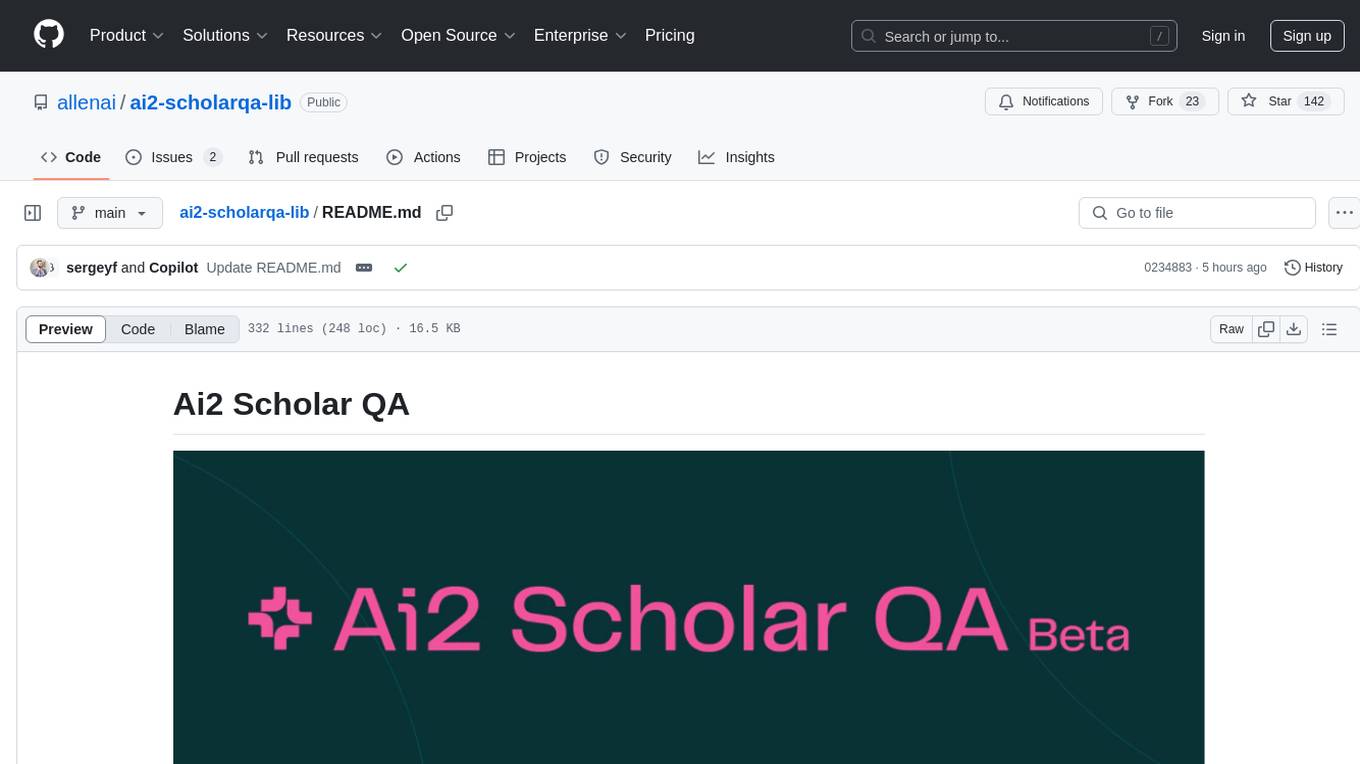
ai2-scholarqa-lib
Ai2 Scholar QA is a system for answering scientific queries and literature review by gathering evidence from multiple documents across a corpus and synthesizing an organized report with evidence for each claim. It consists of a retrieval component and a three-step generator pipeline. The retrieval component fetches relevant evidence passages using the Semantic Scholar public API and reranks them. The generator pipeline includes quote extraction, planning and clustering, and summary generation. The system is powered by the ScholarQA class, which includes components like PaperFinder and MultiStepQAPipeline. It requires environment variables for Semantic Scholar API and LLMs, and can be run as local docker containers or embedded into another application as a Python package.
For similar tasks

mentals-ai
Mentals AI is a tool designed for creating and operating agents that feature loops, memory, and various tools, all through straightforward markdown syntax. This tool enables you to concentrate solely on the agent’s logic, eliminating the necessity to compose underlying code in Python or any other language. It redefines the foundational frameworks for future AI applications by allowing the creation of agents with recursive decision-making processes, integration of reasoning frameworks, and control flow expressed in natural language. Key concepts include instructions with prompts and references, working memory for context, short-term memory for storing intermediate results, and control flow from strings to algorithms. The tool provides a set of native tools for message output, user input, file handling, Python interpreter, Bash commands, and short-term memory. The roadmap includes features like a web UI, vector database tools, agent's experience, and tools for image generation and browsing. The idea behind Mentals AI originated from studies on psychoanalysis executive functions and aims to integrate 'System 1' (cognitive executor) with 'System 2' (central executive) to create more sophisticated agents.
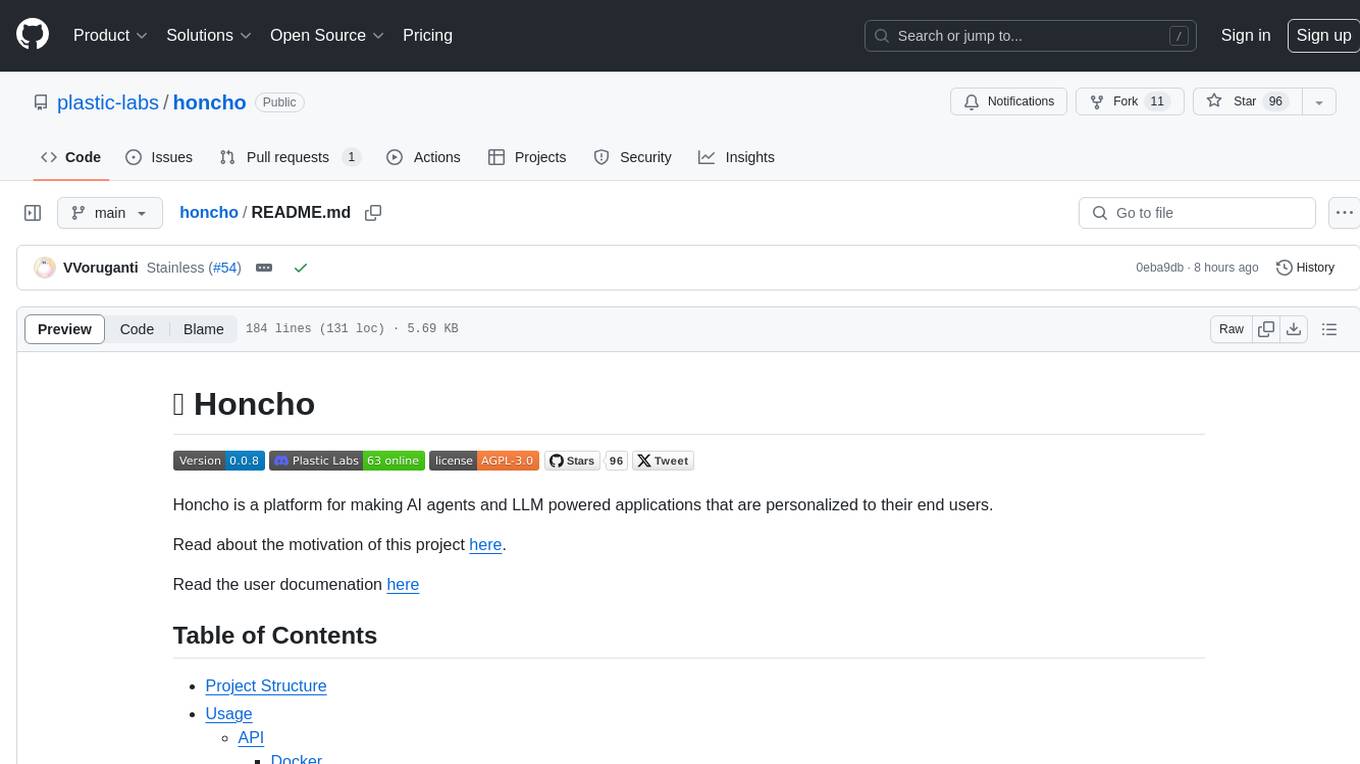
honcho
Honcho is a platform for creating personalized AI agents and LLM powered applications for end users. The repository is a monorepo containing the server/API for managing database interactions and storing application state, along with a Python SDK. It utilizes FastAPI for user context management and Poetry for dependency management. The API can be run using Docker or manually by setting environment variables. The client SDK can be installed using pip or Poetry. The project is open source and welcomes contributions, following a fork and PR workflow. Honcho is licensed under the AGPL-3.0 License.
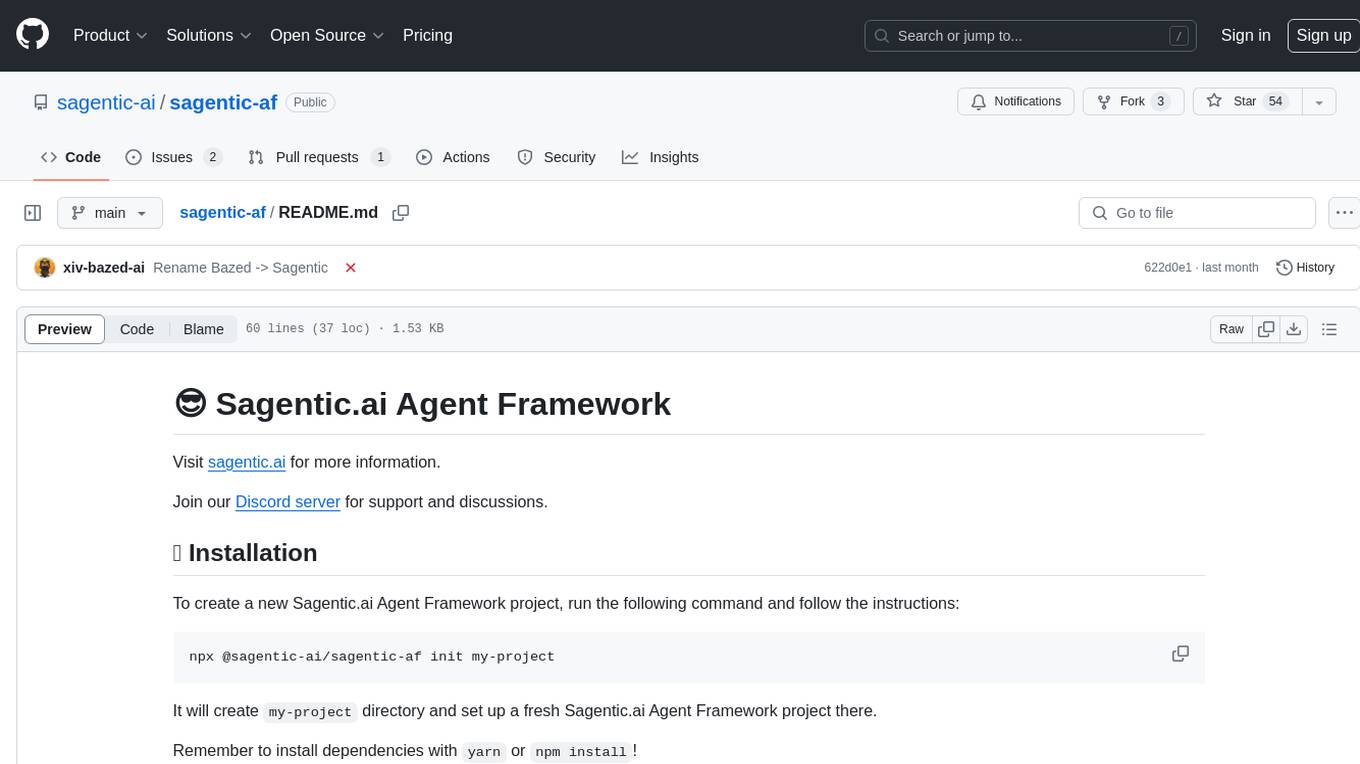
sagentic-af
Sagentic.ai Agent Framework is a tool for creating AI agents with hot reloading dev server. It allows users to spawn agents locally by calling specific endpoint. The framework comes with detailed documentation and supports contributions, issues, and feature requests. It is MIT licensed and maintained by Ahyve Inc.
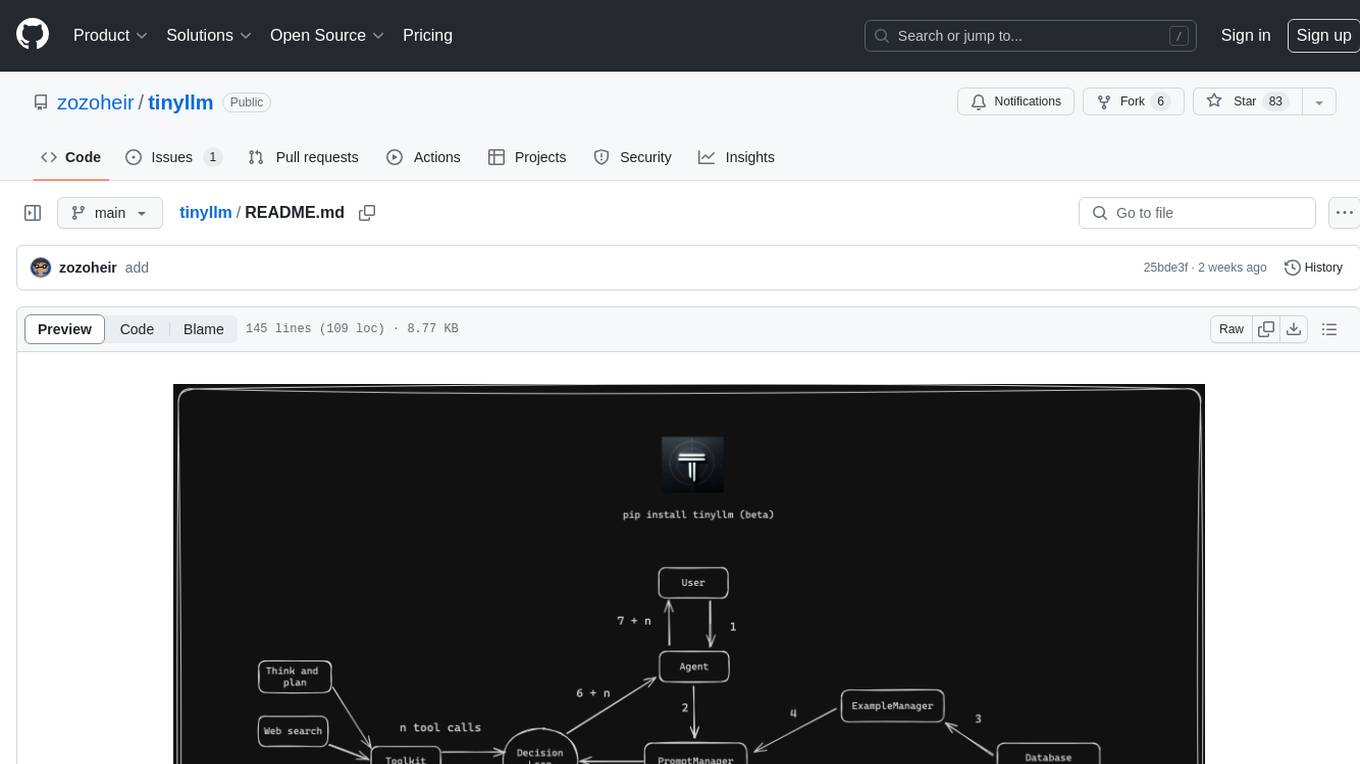
tinyllm
tinyllm is a lightweight framework designed for developing, debugging, and monitoring LLM and Agent powered applications at scale. It aims to simplify code while enabling users to create complex agents or LLM workflows in production. The core classes, Function and FunctionStream, standardize and control LLM, ToolStore, and relevant calls for scalable production use. It offers structured handling of function execution, including input/output validation, error handling, evaluation, and more, all while maintaining code readability. Users can create chains with prompts, LLM models, and evaluators in a single file without the need for extensive class definitions or spaghetti code. Additionally, tinyllm integrates with various libraries like Langfuse and provides tools for prompt engineering, observability, logging, and finite state machine design.
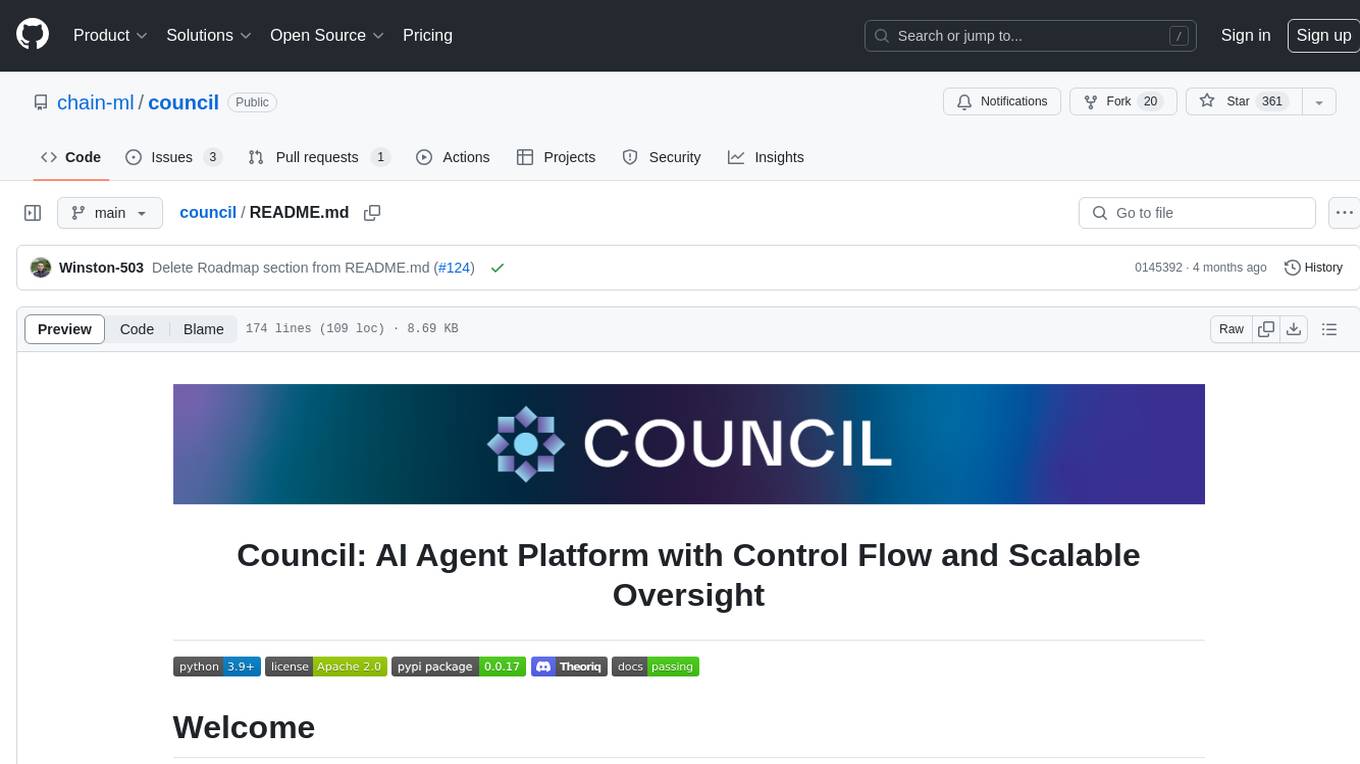
council
Council is an open-source platform designed for the rapid development and deployment of customized generative AI applications using teams of agents. It extends the LLM tool ecosystem by providing advanced control flow and scalable oversight for AI agents. Users can create sophisticated agents with predictable behavior by leveraging Council's powerful approach to control flow using Controllers, Filters, Evaluators, and Budgets. The framework allows for automated routing between agents, comparing, evaluating, and selecting the best results for a task. Council aims to facilitate packaging and deploying agents at scale on multiple platforms while enabling enterprise-grade monitoring and quality control.
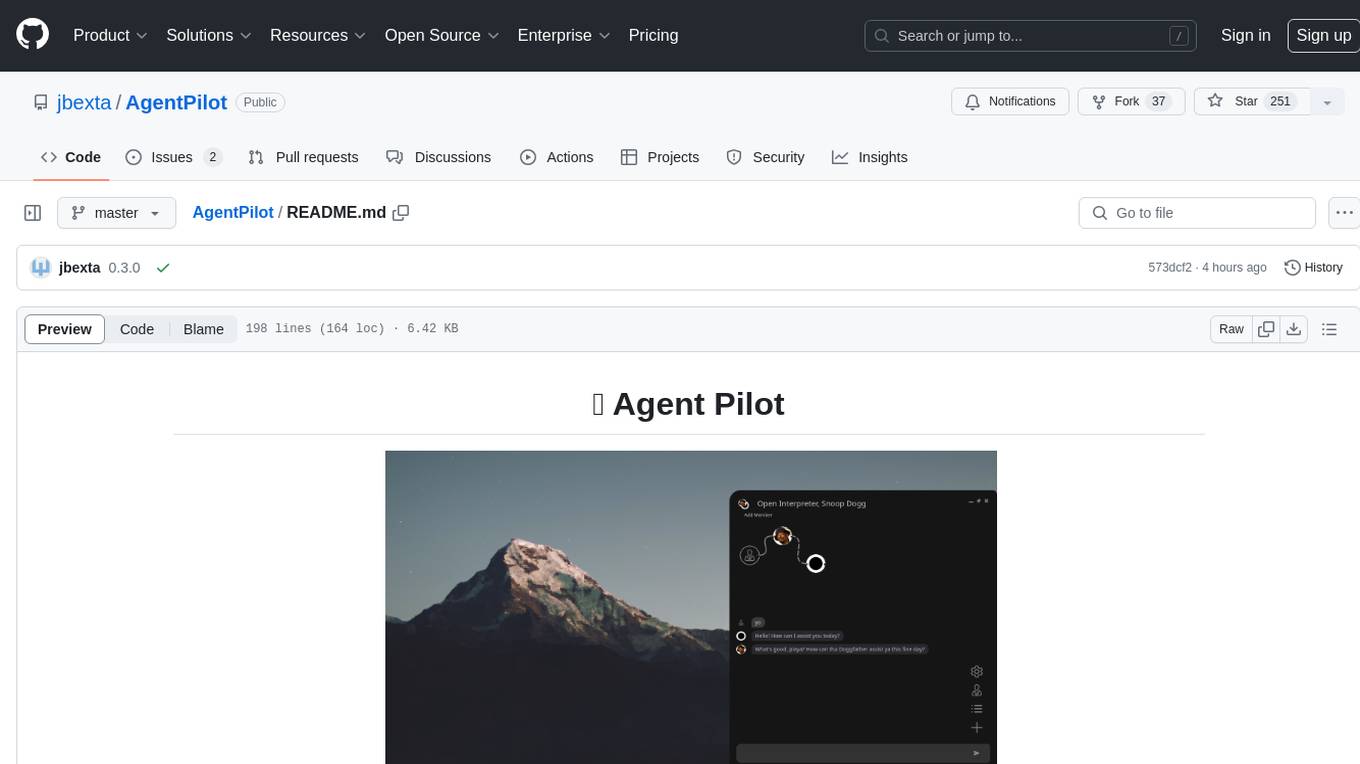
AgentPilot
Agent Pilot is an open source desktop app for creating, managing, and chatting with AI agents. It features multi-agent, branching chats with various providers through LiteLLM. Users can combine models from different providers, configure interactions, and run code using the built-in Open Interpreter. The tool allows users to create agents, manage chats, work with multi-agent workflows, branching workflows, context blocks, tools, and plugins. It also supports a code interpreter, scheduler, voice integration, and integration with various AI providers. Contributions to the project are welcome, and users can report known issues for improvement.
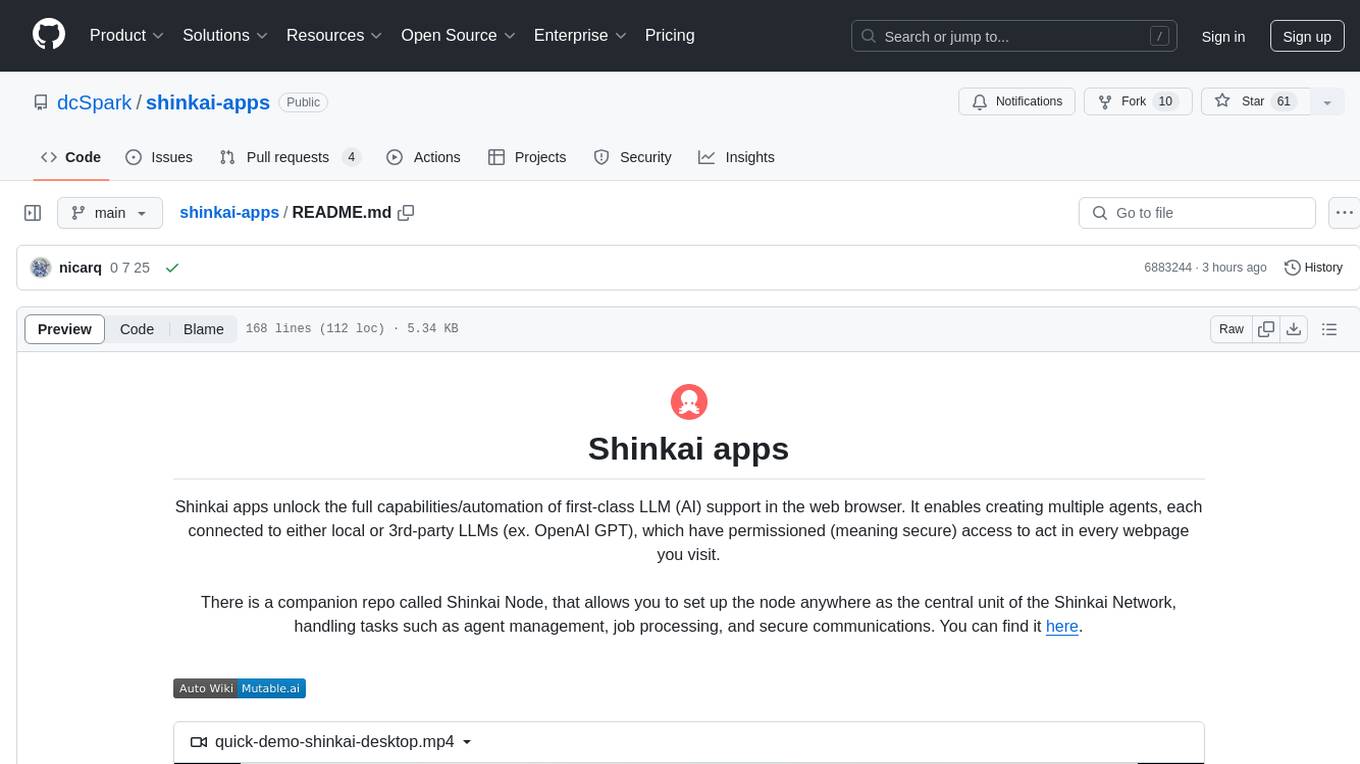
shinkai-apps
Shinkai apps unlock the full capabilities/automation of first-class LLM (AI) support in the web browser. It enables creating multiple agents, each connected to either local or 3rd-party LLMs (ex. OpenAI GPT), which have permissioned (meaning secure) access to act in every webpage you visit. There is a companion repo called Shinkai Node, that allows you to set up the node anywhere as the central unit of the Shinkai Network, handling tasks such as agent management, job processing, and secure communications.
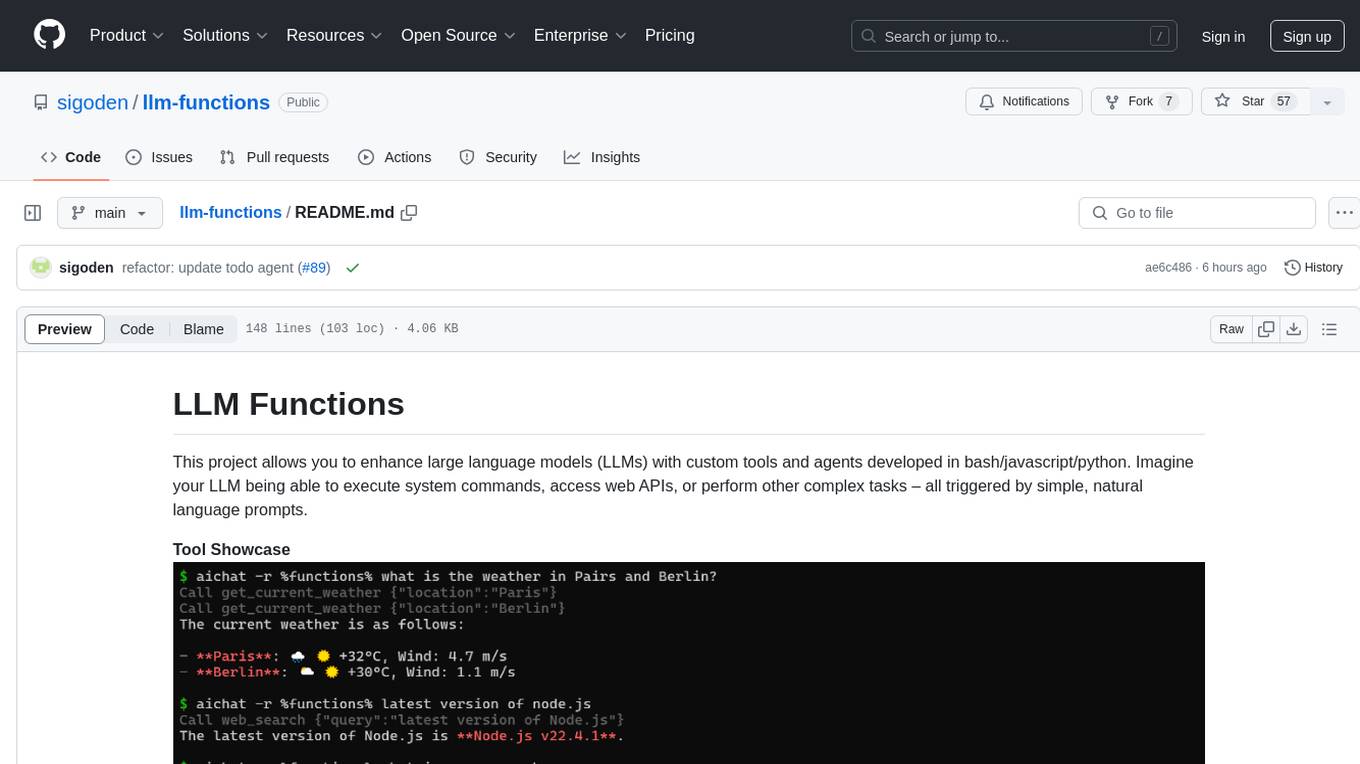
llm-functions
LLM Functions is a project that enables the enhancement of large language models (LLMs) with custom tools and agents developed in bash, javascript, and python. Users can create tools for their LLM to execute system commands, access web APIs, or perform other complex tasks triggered by natural language prompts. The project provides a framework for building tools and agents, with tools being functions written in the user's preferred language and automatically generating JSON declarations based on comments. Agents combine prompts, function callings, and knowledge (RAG) to create conversational AI agents. The project is designed to be user-friendly and allows users to easily extend the capabilities of their language models.
For similar jobs

weave
Weave is a toolkit for developing Generative AI applications, built by Weights & Biases. With Weave, you can log and debug language model inputs, outputs, and traces; build rigorous, apples-to-apples evaluations for language model use cases; and organize all the information generated across the LLM workflow, from experimentation to evaluations to production. Weave aims to bring rigor, best-practices, and composability to the inherently experimental process of developing Generative AI software, without introducing cognitive overhead.

LLMStack
LLMStack is a no-code platform for building generative AI agents, workflows, and chatbots. It allows users to connect their own data, internal tools, and GPT-powered models without any coding experience. LLMStack can be deployed to the cloud or on-premise and can be accessed via HTTP API or triggered from Slack or Discord.

VisionCraft
The VisionCraft API is a free API for using over 100 different AI models. From images to sound.

kaito
Kaito is an operator that automates the AI/ML inference model deployment in a Kubernetes cluster. It manages large model files using container images, avoids tuning deployment parameters to fit GPU hardware by providing preset configurations, auto-provisions GPU nodes based on model requirements, and hosts large model images in the public Microsoft Container Registry (MCR) if the license allows. Using Kaito, the workflow of onboarding large AI inference models in Kubernetes is largely simplified.

PyRIT
PyRIT is an open access automation framework designed to empower security professionals and ML engineers to red team foundation models and their applications. It automates AI Red Teaming tasks to allow operators to focus on more complicated and time-consuming tasks and can also identify security harms such as misuse (e.g., malware generation, jailbreaking), and privacy harms (e.g., identity theft). The goal is to allow researchers to have a baseline of how well their model and entire inference pipeline is doing against different harm categories and to be able to compare that baseline to future iterations of their model. This allows them to have empirical data on how well their model is doing today, and detect any degradation of performance based on future improvements.

tabby
Tabby is a self-hosted AI coding assistant, offering an open-source and on-premises alternative to GitHub Copilot. It boasts several key features: * Self-contained, with no need for a DBMS or cloud service. * OpenAPI interface, easy to integrate with existing infrastructure (e.g Cloud IDE). * Supports consumer-grade GPUs.

spear
SPEAR (Simulator for Photorealistic Embodied AI Research) is a powerful tool for training embodied agents. It features 300 unique virtual indoor environments with 2,566 unique rooms and 17,234 unique objects that can be manipulated individually. Each environment is designed by a professional artist and features detailed geometry, photorealistic materials, and a unique floor plan and object layout. SPEAR is implemented as Unreal Engine assets and provides an OpenAI Gym interface for interacting with the environments via Python.

Magick
Magick is a groundbreaking visual AIDE (Artificial Intelligence Development Environment) for no-code data pipelines and multimodal agents. Magick can connect to other services and comes with nodes and templates well-suited for intelligent agents, chatbots, complex reasoning systems and realistic characters.
